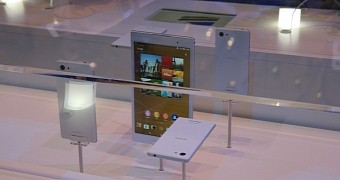The new Modern UI that was introduced on Microsoft’s Windows 8 in October 2012 was criticized by many, not only for being entirely aimed at devices with a touchscreen, but also for its colorful design which, according to some people, is not at all appropriate for the 21st century.
Even though it wasn’t received so well by consumers, the Modern UI inspired many new devices and designs out there, and sometimes it’s really easy to find the resemblance with Microsoft’s own product.
This is the case of some new Sony devices that were introduced at IFA 2014 with much fanfare. Running Android, the Xperia Z3 tablet comes with a Start screen that looks very similar to the one of Windows 8, obviously not so colorful, but still using a live tile-based approach, with description text at the bottom of the icons.
Live tiles are of different sizes on Windows 8, and so are on the new Sony tablet, which could make some wonder whether the new design was indeed inspired by Microsoft’s operating system or not.
Not the first product copying the Metro design
As WMPowerUser writes today, this new design could actually be used by Sony to suggest that their Android device is actually as powerful as the one running Windows, which is obviously subject to many pros and cons.
While we’re not going to make a comparison between Windows and Android tablets, it’s easy to notice that the Metro UI might actually come in very handy to many customers since quite a lot of manufacturers are building similar designs for their smartphones and tablets, no matter the operating system powering them.
Windows 8’s flat look, so not necessarily the Metro UI, influenced the design of several new products that would in the end become much flatter, and the best example is Apple’s iOS.
Starting with iOS 6, Apple’s mobile operating system powering the iPhone and iPad features flat icons, while Mozilla also turned to a new flat icon for the modern version of Firefox.
At the same time, there are quite a lot of transformation packs on the market that allow users to tweak their operating systems and make them look like Windows 8, many of which are also bringing a design very similar to the Modern UI.
Linux is another good example in this case, as lots of distributions that are currently available to users have tweaks that change the looks of the operating system and make it look more like Windows 8.

 14 DAY TRIAL //
14 DAY TRIAL //